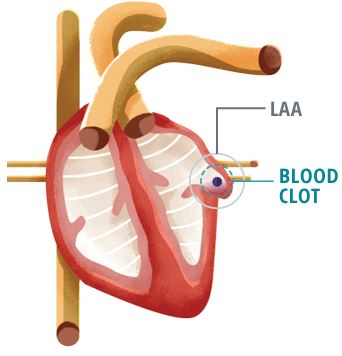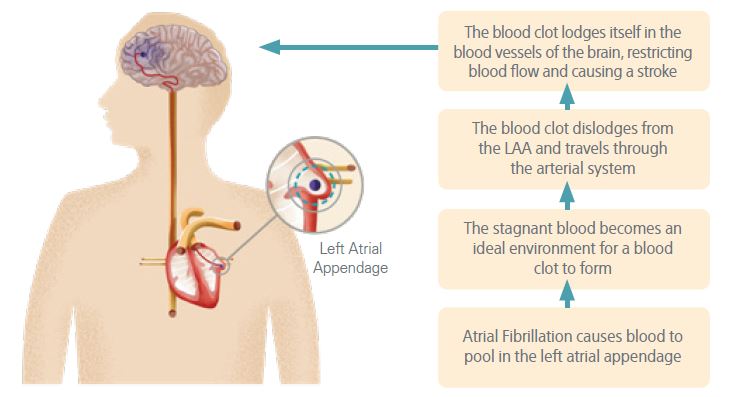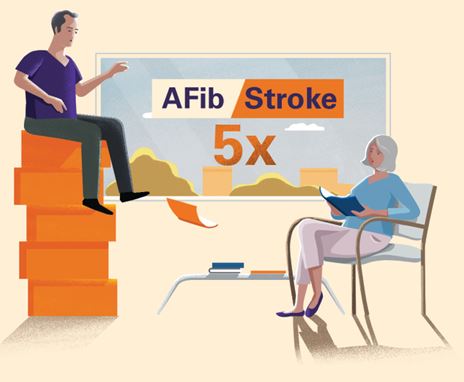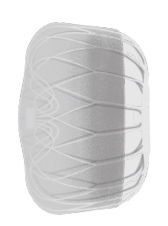Are you at Risk? What Everyone Needs To Know About Atrial Fibrillation & Stroke

What is Atrial Fibrillation?

Atrial fibrillation (AFib) is a heart condition where the upper chambers of your heart (atria) beat too fast and with chaotic rhythm (fibrillation).
This condition can cause blood to pool and form clots in an area of your heart called the left atrial appendage (LAA). If a blood clot forms, it can travel through an artery to the brain and cause a stroke.

How can you tell if you are at risk for stroke?
Anyone can have a stroke no matter your age, race, or gender. But the chances of having a stroke increase if you have certain risk factors:
- Atrial fibrillation (AFib)
- Coronary artery disease
- Diabetes
- High blood pressure
- High cholesterol
- Sleep apnea
Did you know?
People with untreated AFib may be at greater risk for stroke than people with normal heart rhythms. 1
- About one third of people with atrial fibrillation will have a stroke 2
- AFib-related strokes are more frequently fatal and disabling 3,4
- In non-valvular AFib, the left atrial appendage (LAA), a small pouch on the top ofthe heart, is believed to be the source of a majority of stroke-causing blood clots 5
What stroke risks are associated with AFib?

Atrial fibrillation can decrease the heart’s pumping efficiency by as much as 30 percent. Poor pumping increases the risk of clots forming in the heart chambers. Blood clots can break loose and travel in the blood stream to the brain, lungs, and other parts of the body.
Stroke is the most common and perhaps the most feared complication of AFib.
People with AFib have 5 times greater risk of stroke
What are the symptoms of stroke?
Signs of a stroke may include:
- Sudden numbness or weakness of the face, arm, or leg (especially on one side of the body)
- Sudden confusion, trouble speaking, or understanding speech
- Sudden trouble seeing in one or both eyes
- Sudden trouble walking, dizziness, loss of balance, or coordination
- Sudden severe headache with no known cause
A stroke is an emergency situation. If you experience any of these symptoms, call 911 immediately.
How can you reduce your risk of stroke?
Today, a number of treatments are available to protect you from stroke or related complications from blood clots. Your doctor will help you choose a treatment based on your heart’s rhythm, your symptoms, your stroke risk, and any other medical conditions you may have.
Anticoagulants (Blood Thinners)
Medications can reduce the risk of blood clots that could lead to stroke.
Antiplatelet medicines, including aspirin, keep platelets in the blood from sticking together and forming clots.
Anti-clotting medicines, such as warfarin (Coumadin®), Xarelto® (rivaroxaban), Eliquis® (apixaban), Pradaxa® (dabigatran), and Savaysa® (edoxaban) also help prevent clots from forming in your blood.
Blood thinners, or anticoagulants, are very effective at reducing the risk of stroke in people with atrial fibrillation, and most people can take them for years without serious side effects. But because blood thinners help prevent clots by thinning the blood, they also increase the risk of bleeding.
The WATCHMANTM Implant
For those patients considered suitable for blood thinners by their physicians but have reason to seek an alternative, the WATCHMAN Left Atrial Appendage Closure Implant is a one-time procedure alternative to blood thinners that can help reduce stroke risk and bleeding worry for life.
WATCHMAN is implanted in the left atrial appendage of your heart to permanently close off this small pouch and keep harmful blood clots from entering your bloodstream.
By closing off the left atrial appendage, the source of more than 90% of stroke-causing blood clots that come from the heart in people with non-valvular AFib,5 the risk of stroke may be reduced and, over time, you may be able to stop taking your blood thinner.
In a clinical trial with WATCHMAN, 96% of people were able to stop using blood thinners after 45 days.
What is the WATCHMAN Implant?
The WATCHMAN Implant is designed to keep harmful blood clots from entering your blood stream, potentially causing a stroke. It is made of materials that are common to many medical devices, is about the size of a quarter, and cannot be seen outside the body.
WATCHMAN Clinical Program
 WATCHMAN is the only device of its kind approved by the U.S. Food and Drug Administration (FDA) for reducing the risk of stroke in people with atrial fibrillation not caused by a heart valve problem.
WATCHMAN is the only device of its kind approved by the U.S. Food and Drug Administration (FDA) for reducing the risk of stroke in people with atrial fibrillation not caused by a heart valve problem.
More than 150,000 WATCHMAN procedures have been performed worldwide. With almost 20 years of clinical trial and real world experience—including 10 clinical trials—WATCHMAN has a proven safety record.
How is WATCHMAN implanted?
WATCHMAN is implanted into your heart in a one-time, minimally invasive procedure. It’s a permanent implant that doesn’t have to be replaced and can’t be seen outside the body.
To implant WATCHMAN, your doctor makes a small cut in your upper leg and inserts a narrow tube, as done in a standard stent procedure. Your doctor then guides WATCHMAN into the left atrial appendage (LAA) of your heart. The procedure is done under general anesthesia and takes about an hour. Patients commonly stay in the hospital overnight and leave the next day.
Following the WATCHMAN procedure, you’ll take blood thinners for 45 days or until your LAA is permanently closed off. During this time, heart tissue will grow over the implant to form a barrier against blood clots. Your doctor will monitor this process by taking pictures of your heart to see when you can stop taking your blood thinner.
SOUTH WESTERN CARDIAC ARRHYTHMIA INSTITUTE IS IMPLANTING WATCHMAN, AN ALTERNATIVE TO BLOOD THINNERS. IT’S ONE TIME. FOR A LIFETIME. CONTACT US FOR MORE INFORMATION.
Every person with atrial fibrillation has different needs.

If you've been diagnosed with AFib, talk with your doctor about treatment options available to you. Your doctor will help you understand the risks associated with each option.
Together you can choose the treatment that is right for you.
For those patients considered suitable for blood thinners by their physicians but have reason to seek an alternative, WATCHMAN may be an option.
WATCHMAN is for people with atrial fibrillation not caused by a heart valve problem who need an alternative to blood thinners.
Important Safety Information.
The WATCHMAN and WATCHMAN FLX Devices are permanent implants designed to close the left atrial appendage in the heart in an effort to reduce the risk of stroke.
With all medical procedures there are risks associated with the implant procedure and the use of the device. The risks include but are not limited to accidental heart puncture, air embolism, allergic reaction, anemia, anesthesia risks, arrhythmias, AV (Arteriovenous) fistula, bleeding or throat pain from the TEE (Trans Esophageal Echo) probe, blood clot or air bubbles in the lungs or other organs, bruising at the catheter insertion site, clot formation on the device, cranial bleed, excessive bleeding, gastrointestinal bleeding, groin puncture bleed, hypotension, infection/pneumonia, pneumothorax, pulmonary edema, pulmonary vein obstruction, renal failure, stroke, thrombosis and transient ischemic attack. In rare cases death can occur.
Be sure to talk with your doctor so that you thoroughly understand all of the risks and benefits associated with the implantation of the device.
©2020 Boston Scientific Corporation or its affiliates. All rights reserved. All trademarks are property of their respective owners. SH-931902-AA
Sources:
1 Holmes D. Atrial Fibrillation and Stroke Management: Present and Future. Semin Neurol 2010, 30:528-536.
2 Brass L. Stroke. Yale University School of Medical Heart Book.
3 McGrath ER, Neurology. 2013
4 Tu HT, Int J Stroke. 2013
5 Blackshear J. and Odell J., Annals of Thoracic Surgery. 1996;61:755-759.
6
PINNACLE FLX 12-month primary safety and efficacy endpoint results, Doshi, SK. presented at HRS 2020
Science


